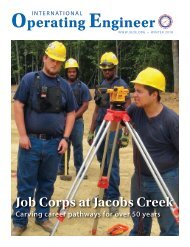International Operating Engineer - Summer 2016
The quarterly magazine of the International Union of Operating Engineers.
The quarterly magazine of the International Union of Operating Engineers.
Create successful ePaper yourself
Turn your PDF publications into a flip-book with our unique Google optimized e-Paper software.
Safety & Health<br />
Zika Virus and Working Outdoors this <strong>Summer</strong><br />
THE OCCUPATIONAL SAFETY<br />
AND HEALTH ADMINISTRATION<br />
(OSHA) and the National Institute for<br />
Occupational Safety and Health<br />
(NIOSH) are monitoring the Zika<br />
virus outbreak and have issued an<br />
Interim Guidance for Protecting<br />
Workers from Occupational<br />
Exposure to Zika Virus.<br />
Zika virus is primarily spread<br />
through the bites of infected<br />
mosquitoes. Mosquitoes can<br />
become infected when they bite<br />
infected persons and can then<br />
spread the Zika virus to other<br />
persons they bite. Aedes species<br />
mosquitoes are the principal<br />
carriers of Zika virus in the United<br />
States. Aedes aegypti (yellow fever<br />
mosquitoes) are typically concentrated<br />
in the southern U.S. as well as parts<br />
of the Southwest (see map). Aedes<br />
albopictus (Asian Tiger mosquitoes)<br />
are found in much of the southern and<br />
eastern part of the U.S. (see map). In<br />
some instances, having contact with<br />
infectious blood or other bodily fluids<br />
of an infected person can result in<br />
transmission of the Zika virus as well.<br />
Approximately one out of five<br />
infected people develop symptoms of<br />
the Zika virus, usually 2-7 days after<br />
exposure. Symptoms are usually<br />
mild and can last 2-7 days. The<br />
most common symptoms of Zika<br />
virus are fever, rash, joint pain,<br />
red or pink eyes, muscle pain, and<br />
headache. You may have also heard<br />
that the Zika virus has been found<br />
to cause neurological problems<br />
in adults. The Brazil Ministry of<br />
Health has reported an increased<br />
number of people who have been<br />
infected with Zika virus who also<br />
have Guillain-Barre Syndrome<br />
(GBS). GBS is an uncommon<br />
sickness of the nervous system in<br />
which a person’s own immune<br />
system damages the nerve<br />
cells, causing muscle weakness, and<br />
sometimes, paralysis. The Center for<br />
Disease Control (CDC) is investigating<br />
the link between Zika and GBS.<br />
Outdoor workers, those doing mosquito control, healthcare workers, and others with potential exposure<br />
to bloodborne pathogens may be exposed to the Zika virus. However, because outdoor workers may be at<br />
the greatest risk of exposure to the virus, OSHA along with NIOSH have developed recommendations for<br />
protecting them from exposure. These recommendations include the following:<br />
• Use insect repellants.<br />
• Wear clothing that covers hands, arms, legs and other exposed skin. Wear hats with mosquito netting<br />
to protect the face and neck. Wear socks/boots that cover the ankles and lower legs.<br />
• In warm weather, wear lightweight, loose-fitting clothing.<br />
• Get rid of sources of standing water (e.g. tires, buckets, cans, bottles, barrels) whenever possible to<br />
reduce or eliminate mosquito breeding areas.<br />
• For females who are or may become pregnant or males who partners are or may become pregnant,<br />
talk to your supervisor about your outdoor work assignments.<br />
• If symptoms develop, seek medical attention promptly. Discuss any possible exposure to mosquitoes<br />
or infections spread by mosquitoes with a healthcare provider.<br />
You have to take into consideration the recommendation along with the type of work you are doing to make<br />
sure the recommendation itself does not create a hazardous work condition. For example wearing loosefitting<br />
clothing if it could be caught in moving parts on a piece of heavy equipment. Heat stress must also<br />
be taken into consideration when wearing clothing that will cover exposed skin during warm/hot weather.<br />
CDC’s Response to Zika<br />
ESTIMATED range of Aedes albopictus<br />
and Aedes aegypti in the United States, <strong>2016</strong>*<br />
CA<br />
CA<br />
HI<br />
CS264451-F<br />
OR<br />
OR<br />
HI<br />
WA<br />
NV<br />
WA<br />
NV<br />
ID<br />
AZ<br />
ID<br />
AZ<br />
UT<br />
UT<br />
PR<br />
PR<br />
MT<br />
WY<br />
CO<br />
NM<br />
MT<br />
WY<br />
CO<br />
NM<br />
ND<br />
SD<br />
NE<br />
TX<br />
KS<br />
KS<br />
OK<br />
Aedes aegypti<br />
ND<br />
SD<br />
NE<br />
TX<br />
OK<br />
MN<br />
MN<br />
IA<br />
IA<br />
MO<br />
AR<br />
LA<br />
MO<br />
AR<br />
LA<br />
WI<br />
WI<br />
IL<br />
MS<br />
IL<br />
MS<br />
IN<br />
AL<br />
IN<br />
MI<br />
TN<br />
AL<br />
MI<br />
TN<br />
KY<br />
KY<br />
OH<br />
GA<br />
OH<br />
GA<br />
WV<br />
WV<br />
SC<br />
FL<br />
SC<br />
FL<br />
PA<br />
VA<br />
NC<br />
Aedes albopictus<br />
PA<br />
VA<br />
NC<br />
NY<br />
NY<br />
VT<br />
NH<br />
MA<br />
RI<br />
CT<br />
NJ<br />
DE<br />
MD<br />
ME<br />
VT<br />
NH<br />
MA<br />
RI<br />
CT<br />
NJ<br />
DE<br />
* Maps have been updated from a variety of sources. These maps represent CDC’s<br />
best estimate of the potential range of Aedes aegypti and Aedes albopictus in the<br />
United States. Maps are not meant to represent risk for spread of disease.<br />
MD<br />
ME<br />
Aedes aegypti mosquitoes are<br />
more likely to spread viruses<br />
like Zika, dengue, chikungunya<br />
and other viruses than other<br />
types of mosquitoes such as<br />
Aedes albopictus mosquitoes.<br />
These maps DO NOT show<br />
· Exact locations or numbers of<br />
mosquitoes living in an area<br />
· Risk or likelihood that these<br />
mosquitoes will spread viruses<br />
These maps show<br />
· CDC’s best estimate of the<br />
potential range of Aedes<br />
aegypti and Aedes albopictus<br />
in the United States<br />
· Areas where mosquitoes are<br />
or have been previously found<br />
8<br />
INTERNATIONAL OPERATING ENGINEER<br />
SUMMER <strong>2016</strong> 9
















